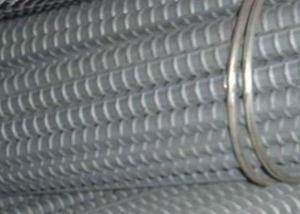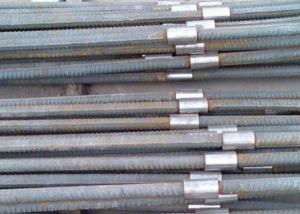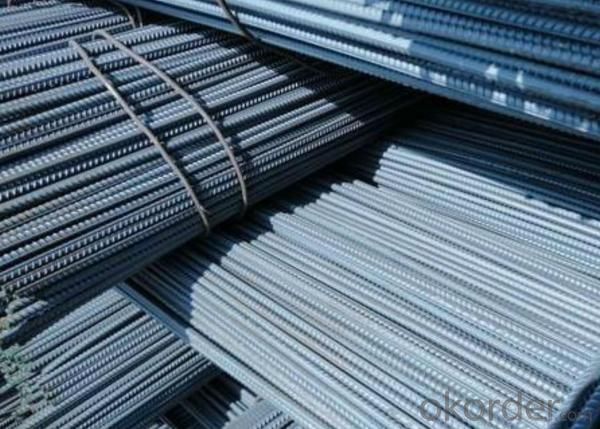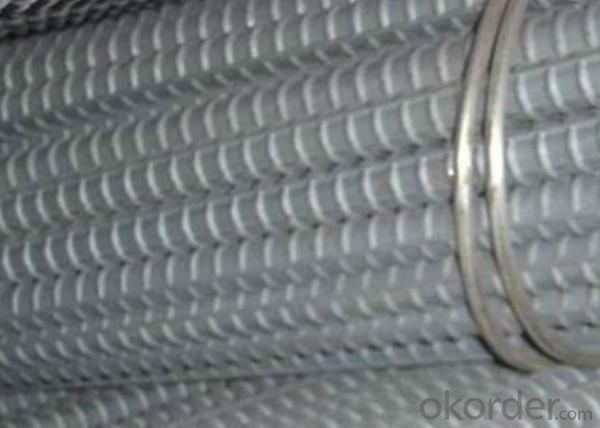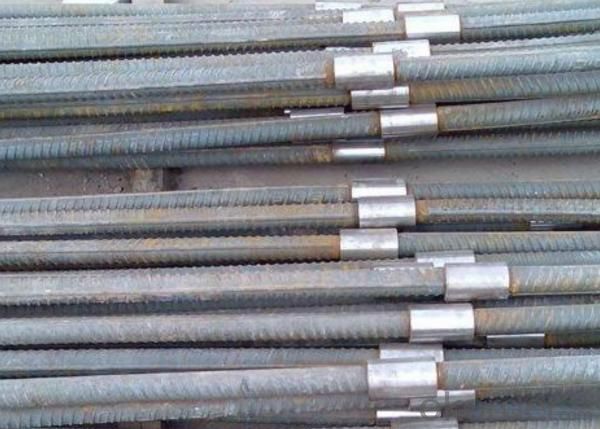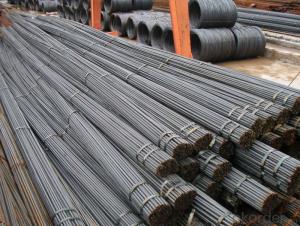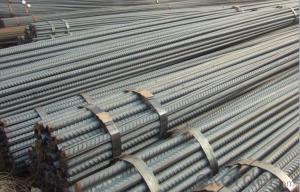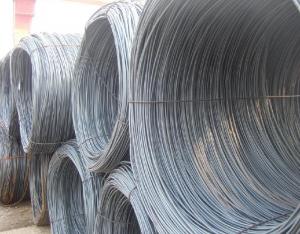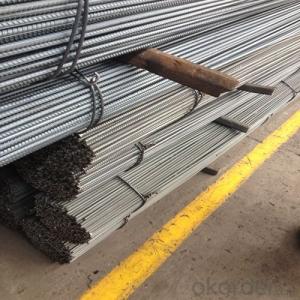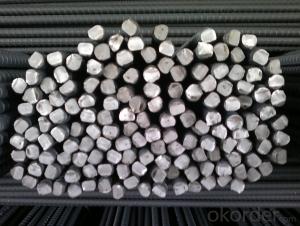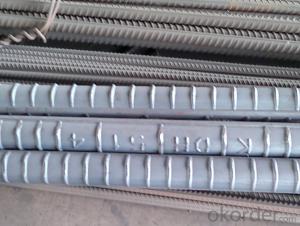HR Steel Rebar
- Loading Port:
- China Main Port
- Payment Terms:
- TT or LC
- Min Order Qty:
- 25MT m.t.
- Supply Capability:
- 800000MT/YEAR m.t./month
OKorder Service Pledge
OKorder Financial Service
You Might Also Like
Specifications of HR Steel Rebar:
Standard | GB | HRB335 HRB400 HRB500 | |
Diameter | 6mm,8mm,10mm,12mm,14mm,16mm,18mm,20mm, 22mm,25mm,28mm,32mm,36mm,40mm,50mm | ||
Length | 6M, 9M,12M or as required | ||
Payment term | TT or L/C | ||
Trade terms | FOB, CFR, CIF | ||
Application | Building, construction | ||
Quality | First quality, the goods are from Chinese big manufacturers. | ||
Type | Hot rolled steel rebar | ||
Brand name | DRAGON | ||
Chemical Composition: (Please kindly find our chemistry of our material based on HRB335, HRB400,HRB500 as below for your information)
Grade | Technical data of the original chemical composition (%) | |||||
C | Mn | Si | S | P | Ceq | |
HRB335 | ≤0.25 | ≤1.60 | ≤0.80 | ≤0.045 | ≤0.045 | 0.52 |
HRB400 | ≤0.25 | ≤1.60 | ≤0.80 | ≤0.045 | ≤0.045 | 0.54 |
HRB500 | ≤0.25 | ≤1.60 | ≤0.80 | ≤0.045 | ≤0.045 | 0.55 |
Theoretical weight and section area of each diameter as below for your information:
Diameter(mm) | Section area (mm²) | Mass(kg/m) |
6 | 28.27 | 0.222 |
8 | 50.27 | 0.395 |
10 | 78.54 | 0.617 |
12 | 113.1 | 0.888 |
14 | 153.9 | 1.21 |
16 | 201.1 | 1.58 |
18 | 254.5 | 2.00 |
20 | 314.2 | 2.47 |
22 | 380.1 | 2.98 |
25 | 490.9 | 3.85 |
28 | 615.8 | 4.83 |
32 | 804.2 | 6.31 |
36 | 1018 | 7.99 |
40 | 1257 | 9.87 |
50 | 1964 | 15.42 |
Usage and Applications of HR Steel Rebar:
Deformed bar is widely used in buildings, bridges, roads and other engineering construction. Big to highways, railways, bridges, culverts, tunnels, public facilities such as flood control, dam, small to housing construction, beam, column, wall and the foundation of the plate, deformed bar is an integral structure material. With the development of world economy and the vigorous development of infrastructure construction, real estate, the demand for deformed bar will be larger and larger..
Packaging & Delivery of HR Steel Rebar:
Packaging Detail: products are packed in bundle and then shipped by container or bulk vessel, deformed bar is usually naked strapping delivery, when storing, please pay attention to moisture proof. The performance of rust will produce adverse effect.
Each bundle weight: 2-3MT, or as required
Delivery Detail: within 45 days after received advanced payment or LC.
Label: to be specified by customer, generally, each bundle has 1-2 labels
Steel Rebar in stock
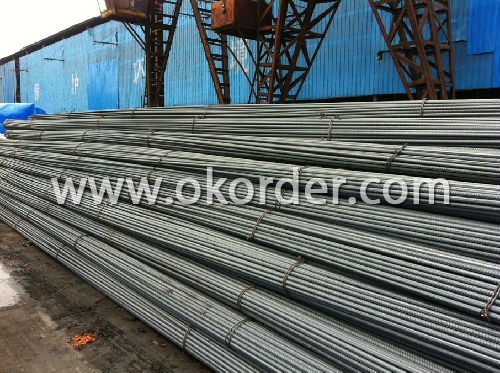
Steel Rebar in production line
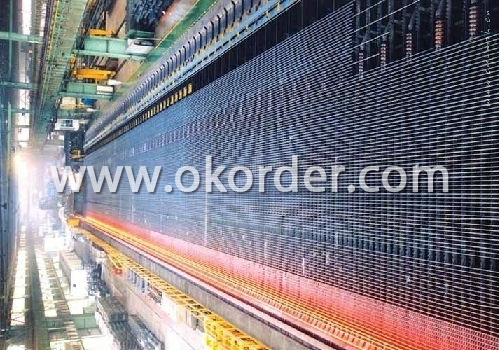
Note:
1. Our products are produced according to national standard (GB), if not, supply according to national standards (GB) or agreement as customer required.
2. Other Grade and Standard Deformed Steel Bar we can supply:
Grade: GR40/GR60, G460B/B500A/B500B/B500C,BST500S
Standard: ASTM, BS, DIN
The Minimum Order Quantity of these products is high, and need to be confirmed.
3. We can not only supply Deformed Steel Bar; if you need anything about building materials, please contact us for further information.
4. Please send us your detail specifications when inquire. We will reply to you as soon as possible. We sincerely hope we can establish a long stable business relationship.
- Q: Can steel rebars be used in retrofitting existing structures?
- Yes, steel rebars can be used in retrofitting existing structures. Retrofitting involves strengthening or upgrading the structural components of a building to improve its performance and safety. Steel rebars are commonly used in this process as they provide added strength and reinforcement to the existing structure, helping it withstand increased loads or seismic forces.
- Q: What is the typical lifespan of steel rebars in a non-corrosive environment?
- In a non-corrosive environment, steel rebars can typically have a lifespan of several decades or even more than 50 years. The absence of corrosion allows the rebars to maintain their structural integrity and strength over an extended period of time.
- Q: How do steel rebars help in preventing cracks in concrete?
- Steel rebars help in preventing cracks in concrete by providing reinforcement and increasing the tensile strength of the structure. When concrete is subjected to tensile forces, it tends to crack. However, the presence of steel rebars within the concrete helps distribute these forces, absorbing the tension and preventing cracks from forming or growing. The rebars act like a skeleton, enhancing the structural integrity and durability of the concrete, ensuring it can withstand various loads and external pressures without significant damage.
- Q: What are the different types of steel rebars available?
- There are several different types of steel rebars available, each with its own unique properties and applications. Some of the most common types include: 1. Mild Steel Rebars: These are the most commonly used type of rebars and are known for their high strength and durability. They are typically used in general construction projects and can withstand heavy loads. 2. High-Strength Deformed (HSD) Rebars: These rebars are made from carbon steel and are heat-treated to enhance their strength and elasticity. They have enhanced resistance to corrosion and are commonly used in high-rise buildings, bridges, and other structures that require extra strength. 3. European Rebars: These rebars are manufactured according to European standards and are typically made from mild steel. They have a ribbed surface to provide better adherence to concrete and are used in various construction applications. 4. Carbon Steel Rebars: These rebars are made from carbon steel and have a high carbon content. They have excellent strength and are widely used in structures that require exceptional durability, such as bridges and highways. 5. Epoxy-Coated Rebars: These rebars are coated with an epoxy layer to prevent corrosion and enhance their longevity. They are commonly used in marine structures and areas with high humidity or salt exposure. 6. Galvanized Rebars: These rebars are coated with a layer of zinc to provide protection against corrosion. They are commonly used in areas with high moisture content or in coastal regions. 7. Stainless Steel Rebars: These rebars are made from stainless steel and are highly resistant to corrosion. They are used in specialized applications, such as in areas with chemical exposure or in structures that require exceptional durability. It is important to choose the appropriate type of steel rebar based on the specific requirements of the construction project, including load-bearing capacity, corrosion resistance, and environmental conditions. Consulting with a structural engineer or construction professional can help determine the best type of rebar to use for a particular project.
- Q: What is the minimum cover required for steel rebars in concrete?
- The minimum cover required for steel rebars in concrete typically depends on the structural design and the intended exposure conditions. However, as a general guideline, the minimum cover requirement for steel rebars in concrete is usually specified as 1.5 inches (38 millimeters) for normal indoor or dry conditions, and may increase to 2 inches (51 millimeters) or more for harsher outdoor or corrosive environments. It is essential to consult the relevant building codes, standards, and engineering professionals to determine the specific minimum cover requirement for a particular project.
- Q: How are steel rebars used in the construction of power transmission towers?
- Steel rebars are commonly used in the construction of power transmission towers to provide reinforcement and strength to the structure. These rebars are typically made of high-strength steel and are used in various components of the tower, such as the foundation, columns, and cross arms. In the foundation, steel rebars are embedded in concrete to increase its load-bearing capacity. The rebars help distribute the weight of the tower and the transmission lines, ensuring that the foundation remains stable and can withstand the forces exerted on it. Within the tower columns, steel rebars are used to reinforce the concrete structure, enhancing its overall strength and stability. This is crucial as power transmission towers are often exposed to strong winds, seismic activities, and other external forces. The rebars prevent the concrete from cracking or collapsing under these conditions, ensuring the tower's integrity and longevity. Steel rebars are also employed in the construction of cross arms, which are the horizontal members that support the transmission lines. These rebars provide additional reinforcement to the cross arms, enabling them to carry the weight of the lines effectively. This is especially important as power transmission lines can span over long distances and carry heavy loads. Overall, steel rebars play a vital role in the construction of power transmission towers by providing the necessary strength and reinforcement to ensure the tower's stability and durability. Without these rebars, the towers would be more susceptible to structural failures and pose a risk to the transmission lines and surrounding areas.
- Q: How do steel rebars affect the overall durability of concrete?
- Concrete structures benefit greatly from the presence of steel rebars, as they significantly contribute to their overall durability. Steel rebars enhance the strength of concrete and its ability to resist external forces and environmental conditions. One of the main functions of steel rebars is to provide tensile strength to concrete, which is naturally weak in resisting tension. Concrete is known for its excellent compressive strength but tends to crack under tension. By embedding steel rebars within the concrete, these cracks are effectively controlled and prevented from expanding, ultimately improving the durability of the structure. Steel rebars also increase the flexural strength of concrete, allowing it to withstand bending and deformations more effectively. This is particularly important in structures such as beams, columns, and slabs that experience significant loads and forces throughout their lifespan. Furthermore, steel rebars act as reinforcement in concrete, enhancing its resistance to external factors like earthquakes, wind, and impact loads. The presence of rebars helps distribute and dissipate these forces throughout the structure, reducing the risk of structural failure and increasing overall durability. Another crucial aspect is the prevention of corrosion in reinforced concrete structures. Steel rebars are typically coated with materials that protect them from corrosion caused by moisture and chemical reactions. This protective coating, combined with the alkaline environment of concrete, forms a barrier that significantly slows down the corrosion process, ultimately increasing the longevity and durability of the concrete structure. To conclude, steel rebars play a vital role in enhancing the overall durability of concrete structures. They provide necessary tensile strength, improve flexural strength, enhance resistance to external forces, and prevent corrosion. Incorporating steel rebars makes concrete more robust, long-lasting, and capable of withstanding various challenges, ensuring the longevity and safety of the structure.
- Q: Are there any limitations on the length of steel rebars?
- There are limitations on the length of steel rebars, which are typically set by industry standards and guidelines. These limitations are mainly determined by practical and logistical factors. One limitation is related to transportation and handling of rebars. Steel rebars are typically manufactured in long lengths, often up to 60 feet (18 meters) or more. However, due to the weight and stiffness of steel rebars, it becomes challenging to transport and maneuver such long lengths. Therefore, rebars are often cut into shorter lengths for ease of transportation and handling on construction sites. Another limitation is related to the structural integrity of the rebars. Longer rebars may be more prone to bending, warping, or sagging, which can compromise their effectiveness in reinforcing concrete structures. To ensure structural integrity, rebars are often limited to specific lengths based on the specific application and design requirements. Additionally, there may be limitations imposed by local building codes and regulations. These codes and regulations aim to ensure the safety and durability of structures. They may specify the maximum length of steel rebars that can be used in different construction applications to meet the required standards and ensure the structural integrity of the building. In summary, while steel rebars can be manufactured in long lengths, practical considerations, structural integrity, and local regulations often impose limitations on their length. These limitations are in place to ensure the efficient handling and transportation of rebars, maintain their structural integrity, and comply with building codes and regulations.
- Q: What are the different types of steel rebars?
- There are several types of steel rebars used in construction, including conventional carbon steel rebars, epoxy-coated rebars for corrosion resistance, stainless steel rebars for high strength and corrosion resistance, and galvanized rebars for added protection against corrosion.
- Q: What is the effect of exposure to UV radiation on steel rebars?
- Exposure to UV radiation can cause degradation and damage to steel rebars. The radiation can lead to the breakdown of the protective oxide layer on the surface of the steel, making it more susceptible to corrosion. Additionally, UV radiation can induce surface pitting and cracking, compromising the structural integrity of the rebars. Therefore, it is crucial to protect steel rebars from prolonged exposure to UV radiation to ensure their long-term durability and safety in construction projects.
1. Manufacturer Overview
| Location | Hebei, China |
| Year Established | 2002 |
| Annual Output Value | Above US$ 400 Million |
| Main Markets | South Asia; Middle East;Southeast Aisa |
| Company Certifications |
2. Manufacturer Certificates
| a) Certification Name | |
| Range | |
| Reference | |
| Validity Period |
3. Manufacturer Capability
| a) Trade Capacity | |
| Nearest Port | Tianjin |
| Export Percentage | 60%-80% |
| No.of Employees in Trade Department | 11-20 People |
| Language Spoken: | English; Chinese |
| b) Factory Information | |
| Factory Size: | Above 100,000 square meters |
| No. of Production Lines | 2 |
| Contract Manufacturing | OEM service offered |
| Product Price Range | average |
Send your message to us
HR Steel Rebar
- Loading Port:
- China Main Port
- Payment Terms:
- TT or LC
- Min Order Qty:
- 25MT m.t.
- Supply Capability:
- 800000MT/YEAR m.t./month
OKorder Service Pledge
OKorder Financial Service
Similar products
Hot products
Hot Searches
Related keywords

